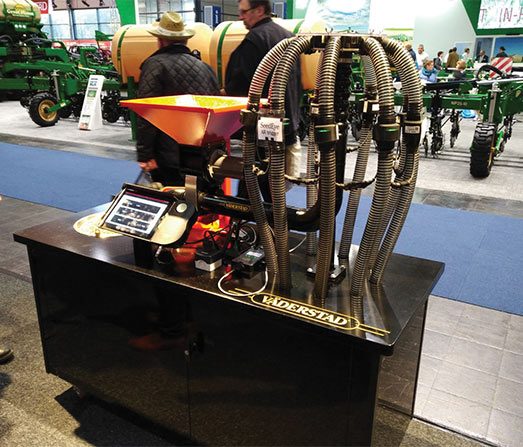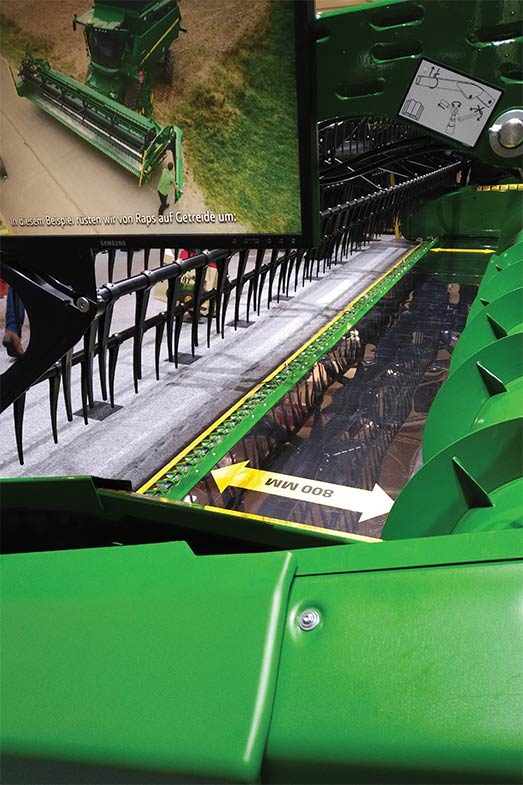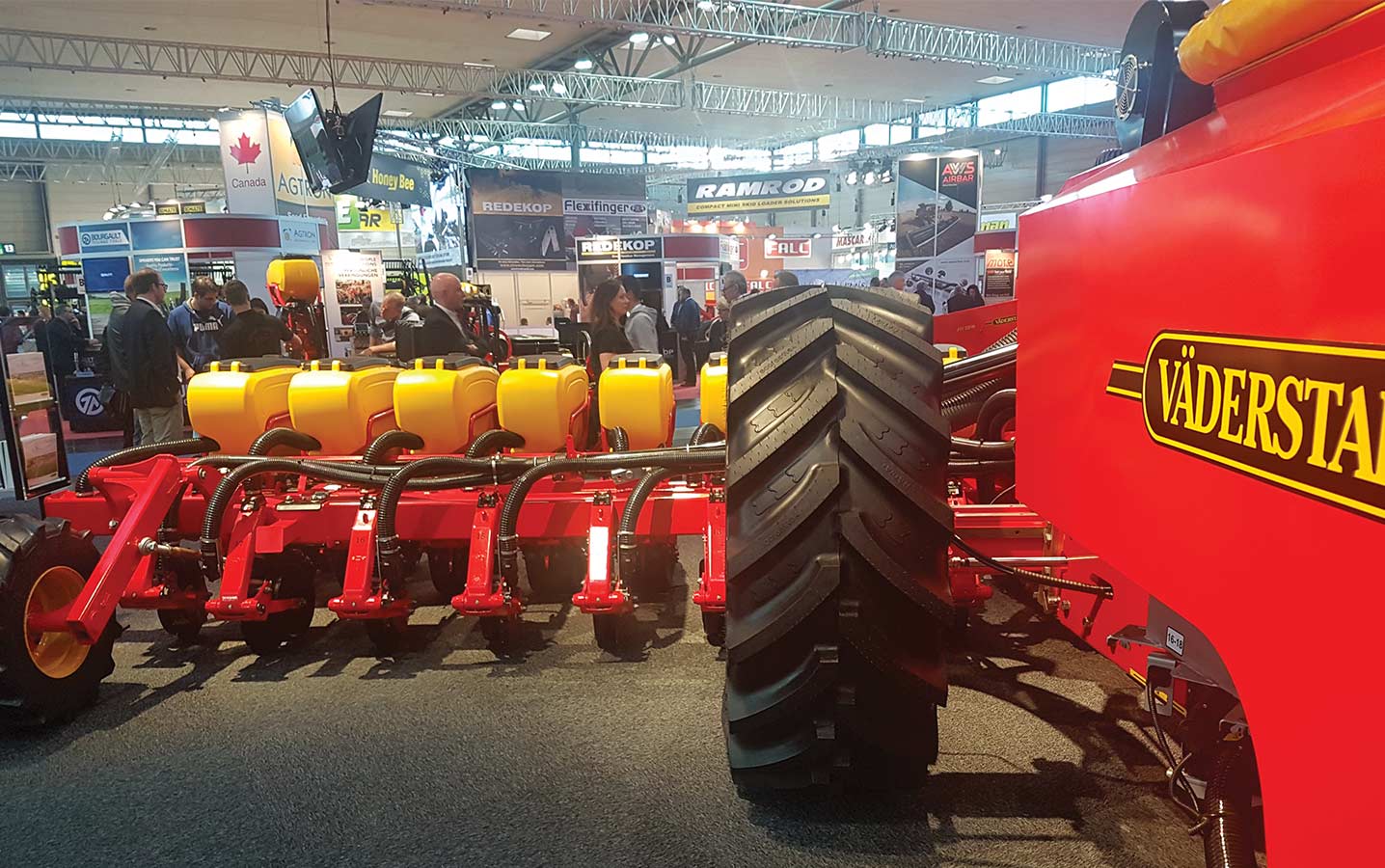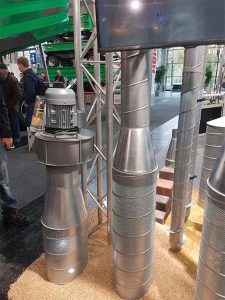What won us over in Hanover?
Agritechnica agricultural trade show in Hanover, Germany attracted 450,000 visitors this year, according to the official website, with more than 100,000 coming from outside of Germany. All were coming to see some of the 2,803 international exhibitors in a covered area of more than 100 acres.
We went to Agritechnica with a mission to see and learn about new production technology for winter oilseed rape, a very important crop in much of Europe. We wanted to find innovations that could benefit Canadian canola growers.
On our list to investigate were header technology for direct cutting, seeding equipment (specifically those set up for small-seeded crops) and precision ag technology. Further to that, we hoped to stumble upon other novel products and academic research.
Immediately striking is how elaborate and professional the exhibits are, with every detail from layout to lighting well executed. A lot of exhibits have technology available in both English and German to guide the learning experience if a company representative is not available.
Although we were not particularly focused on tillage implements, they were everywhere. It seemed every unit had multiple disturbance methods, and they were often in combination with a tool of another function. One-pass tillage and seeders were common, and we saw some tillage and sprayer combinations. To further facilitate this many-jobs-at-once approach, most tractors are equipped to mount implements front and back.
Seeders
Seeding with planters in Europe is common, but not into direct or min-till systems. Typical seeding rates used are in the 20-30 seeds per square meter. A few of the manufacturers have lines with heavier frames and openers and are investigating options for use in reduced tillage, but some of the smaller manufactures systems were not currently robust enough to handle reduced tillage. Most of the companies selling planters also had a line of very aggressive tillage equipment for pre-working to compliment them. One plans to field-test its high-speed planter in fields across Western Canada in 2018. Row spacing, although adjustable on many of the planters, still remains wider than the range that research in Western Canada has shown to be ideal.

Precision spreaders
The spreader and broadcasting equipment section was so large it alone would take up most of the space at most Western Canada ag shows. Precision options, including variable rate, have really improved the simple spin spreader. Sectional control reduces overlap while keeping the proper rate across the remaining spread area. We see this technology being useful with current work looking at lime application for control of clubroot. With high rates and significant costs involved, being able to precisely apply a varying rate would make it more affordable and productive. As crop yields increase and sustainability measures become more and more stringent, the ability to apply all the nutrients for a crop up front may not be a possibility, so technology like this may be needed to precisely add nutrients.

Headers
It was easy to find header technology designed specifically for straight cutting canola and rapeseed. European producers want a header that can work for all crops, and most company representatives agree that this is the “variable-knife” auger header – which we have very recently seen in Canada. Agritechnica had many versions on offer. Companies like BISO also had kits to modify conventional headers.
With these variable-knife headers, the cutterbar can be adjusted from the cab, with an extension typically out to at least 24 inches. The furthest extension we saw was just over 30 inches, but there may be models that go further. The knife can be brought in as close or closer than would be typical for a conventional auger header. We also saw flex auger headers with variable cutterbars.
Most headers were equipped with vertical knife dividers, crop lifters, steel pick-up fingers on the reel and full-fingered augers. Only one draper header was seen throughout the show, and representatives told me that the market share in Europe is very low. One model was a hybrid between an auger and draper, with a narrow draper on the table in front of the auger.
Some headers had more aggressive feeding pieces at the feeder house. A few companies offered headers that could be put into transport mode from the cab, with one or multiple sections folding on top of the other.
Although Europeans are much further along and experienced in direct cutting, our Agritechnica experiences suggest we’re on the right track as we move toward more acres being harvested this way in Canada.

Storage
Storing in bins does not appear to be as common in Europe as it is in Canada, but there was a larger focus on storage and storage-monitoring tools than traditionally seen at this type of show.
We saw the “FlexWave” technology for the first time. The unloading system for bins has an in-floor conveyer and balloon-like system that expands and deflates on each side to push the last of the grain into the conveyer.
Other observations
As we walked through the show, we noticed that:
- Most implements had markers for guidance.
- Companies have a large focus on pull type, high-
clearance sprayers. These appeared to be more common than self-propelled sprayers. - A lot of companies have an emphasis on their ability to compensate for varying terrain. Exhibit promotions often showed how an implement’s tires and the axles adjust over rolling terrain.
- Efficiency, precision and input reduction were the name of the game for both existing and prototype units. Examples were the hybrid units, like the self-propelled sprayer and fertilizer spreader combo from Amazone and precision technologies that pinpoint application needs in real time.
- Many companies incorporate apps and technology to remove as much of the manual requirements as possible. For instance, Vaderstad uses an app to calibrate the planting unit, working through a Wi-Fi signal from the planting unit itself.
- There appears to be a lot of collaboration between companies. For instance, “agri-router” is a data services program from DKE Data that allows all forms of data from participating companies to “speak the same language.” This eliminates the problem of multiple platforms from different brands of equipment that are not compatible. Ten companies are currently participating.
Conclusion
We could have spent more than two days at Agritechnica. We missed more exhibits than we investigated. The overwhelming diversity of equipment, tools, inputs and projects on display from around the world was a great example of the continued investment and innovation put forth to advance agricultural practices.
By: Shawn Senko and Angela Brackenreed







